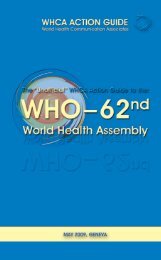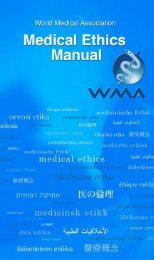the basics - World Health Communication Associates
the basics - World Health Communication Associates
the basics - World Health Communication Associates
- No tags were found...
Create successful ePaper yourself
Turn your PDF publications into a flip-book with our unique Google optimized e-Paper software.
Coughs and colds only get better with medicineIt is <strong>the</strong> fa<strong>the</strong>r’s gene that decides whe<strong>the</strong>r <strong>the</strong> baby is a boy or a girlAntibiotics kill viruses as well as bacteriaCigarette smoking causes lung cancerAll bacteria are harmful to humans(F)(T)(F)(F)(F)Pleasant and Kuruvilla suggest (2008) that this scale can meet <strong>the</strong> needs ofresearchers concerned with <strong>the</strong> relationships between knowledge and health andinform advocacy efforts to improve <strong>the</strong> flow of health information to promotehealthy behaviors, prevent and treat individual diseases, conditions or health issues.Moreover, <strong>the</strong> scale could be used as a core measure for national survey effortsinvestigating <strong>the</strong> relationship between knowledge and health similar to <strong>the</strong> U.S.National Science Board’s and Eurobarometer efforts to assess changes and effects ofscience literacy in society.3.5 A MEASURE OF HEALTH DEVELOPMENTRatzan (2001) and o<strong>the</strong>rs have proposed that population health literacy shouldbe considered a measure of health development. A population health literacyindex which measures a person’s skills and <strong>the</strong> health literacy friendliness of keysystems and settings could provide a useful and unique picture of populationhealth competence. Such an index could provide a new type of health index forsocieties that complements measures such as <strong>the</strong> disability adjusted life years(DALYs) and morbidity and mortality data (Ratzan 2001; Kickbusch 2002). The IOMRoundtable 2009 heard several presentations of approaches to population healthliteracy measurement, including geo-mapping using census data and literacymeasures (Lurie in Hernandez 2009, p.66) and ano<strong>the</strong>r imputing health literacybased on patient sociodemographic indicators such as age, education, etc. (Hanchatein Hernandez 2009, p.61). This is an area for future research.SECTION 3: HOW IS HEALTH LITERACY MEASURED? 31






